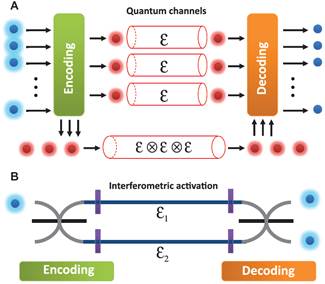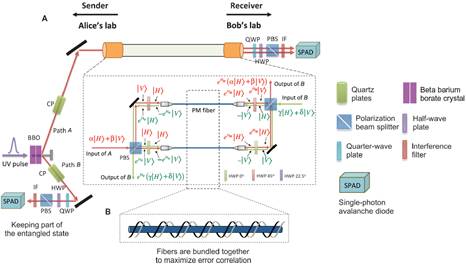The capacity of a channel is a central issue in quantum communication, which describes the ability to transmit noiseless information in noisy channels. Unlike classical channels, in which capacity can be well described by Shannon’s theorem, the case of quantum channels are more complex.Quantum channels can be used to transmit classical information, private classical information and quantum information. Each of them represents a kind of capacity of quantum channels. In standard quantum channel theory, where channels are assumed to be independent and uncorrelated, many interesting results have been obtained. However, quantum channel may be more complex in practice.
Professor LI Chuanfeng and XU Jinshi from Key Laboratory of Quantum Information, University of Science and Technology of China, together with collaborators, have made breakthrough in correlated quantum channels. They experimentally realized bidirectional quantum information transmission in quantum channels each with zero quantum capacity, which leads to a deep understanding of activation phenomenon in noisy quantum channel. The result is published online in Science Advances on Jan. 8, 2016.
In the work, they chose polarization-maintaining (PM) fibers as quantum channels. Due to the strong birefringence effect, PM fibers have short coherence length for maintaining coherence of quantum information. To rigorously quantify the amount of quantum information transferred, the optical fibers are analyzed with the tools developed in quantum communication theory. They showed that the quantum capacity of a 120-meter-long PM fiber is a good approximation to a zero-capacity quantum channel. They then encoded a pair of 120-meter-long PM fibers and constructed a quantum channel interferometer, in which the capacity of the PM fibers was activated. In such case, these two fibers were not independent anymore. They were correlated and formed a decoherence-free subspace, in which quantum information can be transmitted noiselessly. In the experiment, the two fibers were bundled together to maximize error correlation. The quantum capacity of the correlated PM fibers were measured to be larger than 0.6. There were two input ports and two output ports in the quantum channel interferometer. Different types of setting of the half-wave plates in the interferometer allow the setup to be operated in either bidirectional mode or the unidirectional mode. They further verified that the setup can be used to transmit nonlocal quantum information.
These results not only suggest a practical means for protecting quantum information sent through optical quantum networks, but also provide potentially a new physical platform for enriching the structure of the quantum communication theory.
The work was supported by National Natural Science Foundation, Ministry of Science and Technology, Chinese Academy of Sciences, Synergetic Innovation Center of Quantum Information and Quantum Physics.

Fig 1: The comparison between (A) standard quantum channel theory and (B) the interferometric activation technology. (A) Photons can pass through each channel or same channel one after another after encoding. (B) A Photon can travel through different channels after encoding./ Coutesy by LI Chuanfeng's group.

Fig 2: Experimental setup/ Coutesy by LI Chuanfeng's group